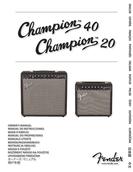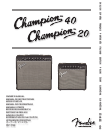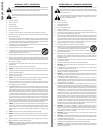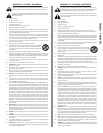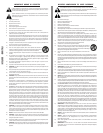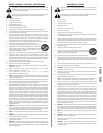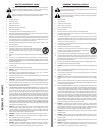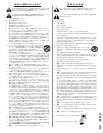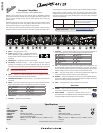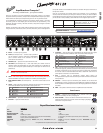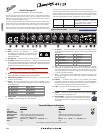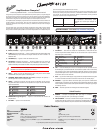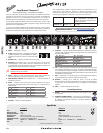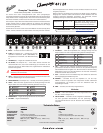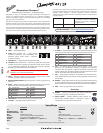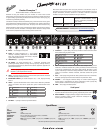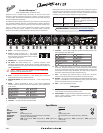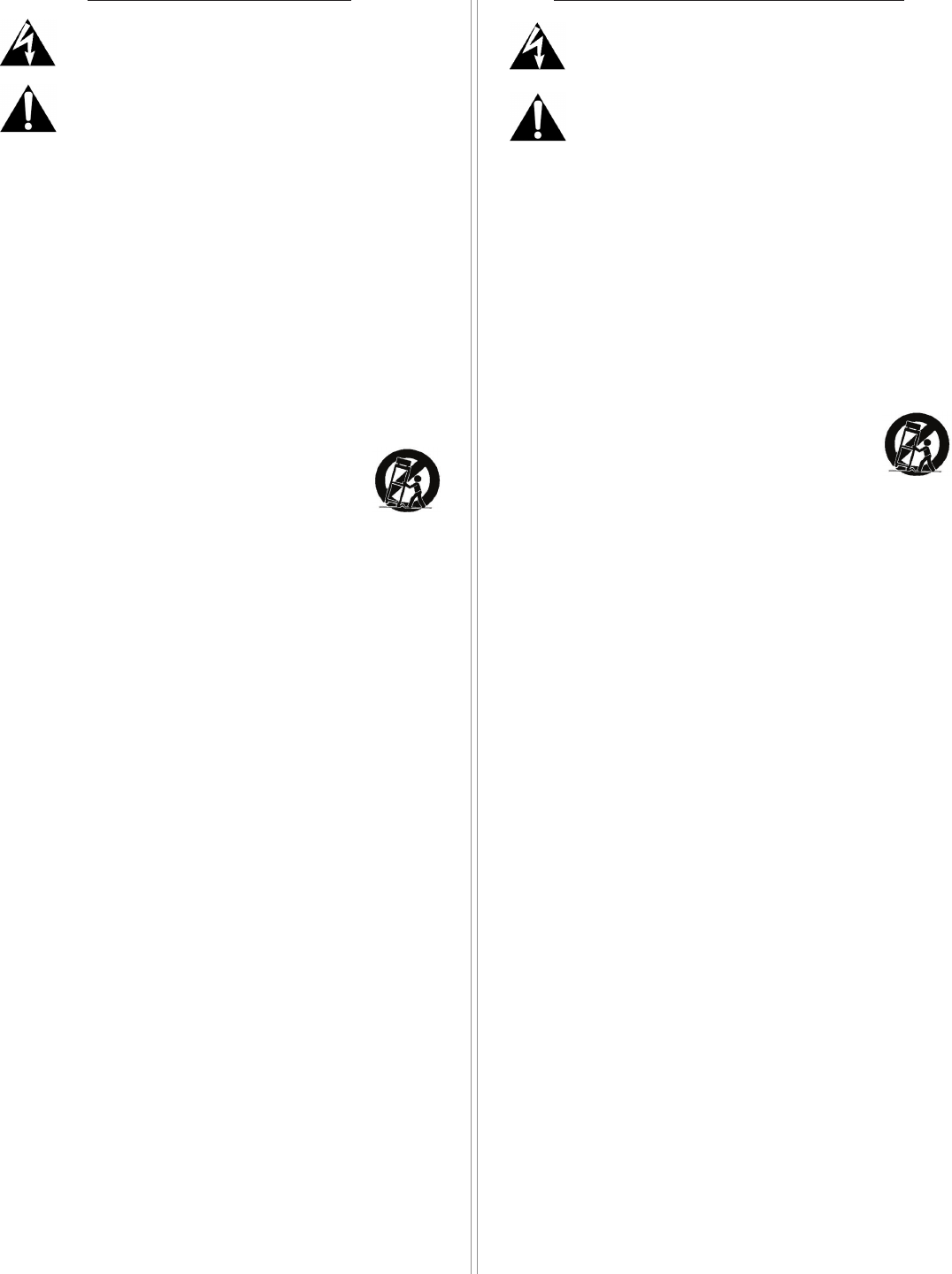
IMPORTANT SAFETY INSTRUCTIONS
The lightning flash with arrowhead symbol within an equilateral triangle is intended to alert the
user to the presence of uninsulated “dangerous voltage” within the product’s enclosure that may
be of sufficient magnitude to constitute a risk of electric shock to persons.
The exclamation point within an equilateral triangle is intended to alert the user to the presence
of important operating and maintenance (servicing) instructions in the literature accompanying
the product.
1) Read these instructions.
2) Keep these instructions.
3) Heed all warnings.
4) Follow all instructions.
5) Do not use this apparatus near water.
6) Clean only with dry cloth.
7) Do not block any ventilation openings. Install in accordance with the manufacturer’s instructions.
8) Do not install near any heat sources such as radiators, heat registers, stoves, or other apparatus (including
amplifiers) that produce heat.
9) Do not defeat the safety purpose of the polarized or grounding-type plug. A polarized plug has two
blades with one wider than the other. A grounding type plug has two blades and a third grounding
prong. The wide blade or the third prong are provided for your safety. If the provided plug does not fit
into your outlet, consult an electrician for replacement of the obsolete outlet.
10) Protect the power cord from being walked on or pinched particularly at plugs, convenience receptacles
and the point where they exit from the apparatus.
11) Only use attachments/accessories specified by the manufacturer.
12) Use only with the cart, stand, tripod, bracket, or table specified by the manufacturer
or sold with the apparatus. When a cart is used, use caution when moving the cart/
apparatus combination to avoid injury from tip-over.
13) Unplug this apparatus during lightning storms or when unused for long periods of time.
14) Refer all servicing to qualified service personnel. Servicing is required when the apparatus has been
damaged in any way, such as power-supply cord or plug is damaged, liquid has been spilled or objects
have fallen into the apparatus, the apparatus has been exposed to rain or moisture, does not operate
normally, or has been dropped.
15) To completely disconnect this apparatus from the AC mains, disconnect the power supply cord plug from
the AC receptacle.
16) The mains plug of the power supply cord shall remain readily operable.
17) WARNING – To reduce the risk of fire or electric shock, do not expose this apparatus to rain or moisture.
18) Do not expose this equipment to dripping or splashing and ensure that no objects filled with liquids, such
as vases, are placed on the equipment.
19) Maintain at least 6 inches (15.25 cm) of unobstructed air space behind the unit to allow for proper
ventilation and cooling of the unit.
20) CAUTION – For rack mounted power amplifiers, keep all wiring and materials away from the sides of the
unit and allow the unit to cool down for 2 minutes before pulling from a rack enclosure.
21) Amplifiers and loudspeaker systems, and ear/headphones (if equipped) are capable of producing very
high sound pressure levels which may cause temporary or permanent hearing damage. Use care when
setting and adjusting volume levels during use.
22) FCC COMPLIANCE NOTICE: This equipment has been tested and found to comply with the limits for a Class
B digital device, pursuant to Part 15 of the FCC rules. These limits are designed to provide reasonable
protection against harmful interference in a residential installation. This equipment generates, uses
and can radiate radio frequency energy and if not used in accordance with the instructions, may cause
harmful interference to radio communications and there is no guarantee that interference will not occur
in a particular installation. If this equipment does cause harmful interference to radio or television
reception, which can be determined by turning the equipment off and on, the user is encouraged to try
to correct the interference by one or more of the following measures: reorient or relocate the receiving
antenna, increase the separation between the equipment and receiver, connect the equipment into
an outlet on a circuit different from that of the receiver. Consult the dealer or an experienced radio/
TV technician if help is needed with interference. NOTE: FMIC will not be responsible for unauthorized
equipment modifications that could violate FCC rules, and/ or void product safety certifications.
23) WARNING – To maintain product safety, products with internal or external (battery pack) batteries:
•Batteries and/or the product in which they are installed, shall not be exposed to excessive heat such
as sunshine, fire or the like. •There may be a danger of explosion if the battery is incorrectly connected/
replaced. Replace only with the same or equivalent type battery specified in the instructions or on the
product.
24) CAUTION – Unplug unit and allow it to cool before touching/ replacing vacuum tubes.
25) WARNING – Provide an earthing connection before the mains plug is connected to the mains. And, when
disconnecting the earthing connection, be sure to disconnect after pulling out the mains plug from the
mains.
26) Apparatus with CLASS I construction (grounded type with a three-prong plug) must be connected to a
MAINS socket outlet with a protective earthing connection.
27) WARNING – Use only the AC/DC adapter provided with the amplifier. The unit must only be connected
to a safety agency certified power source (adapter), approved for use and compliant with applicable local
and national regulatory safety requirements.
INSTRUCCIONES DE SEGURIDAD IMPORTANTES
El relámpago con el símbolo de cabeza de flecha dentro de un triángulo equilátero tiene por
objeto alertar al usuario de la presencia de “voltaje peligroso” no aislado dentro del gabinete del
producto, que puede ser de magnitud suficiente como para constituir un riesgo de descarga
eléctrica para las personas.
El signo de admiración dentro de un triángulo equilátero tiene por objeto alertar al usuario a la
presencia de importantes instrucciones de operación y mantenimiento (servicio) en los
documentos que acompañan al producto.
1) Lea estas instrucciones.
2) Conserve estas instrucciones.
3) Atienda todas las advertencias.
4) Siga todas las instrucciones.
5) No use este aparato cerca del agua.
6) Limpie sólo con un paño seco.
7) No bloquee ningún orificio de ventilación. Instale de acuerdo con las instrucciones del fabricante.
8) No lo instale cerca de ninguna fuente de calor, como radiadores, registros de calefacción, estufas u otros
aparatos (incluidos los amplificadores) que produzcan calor.
9) No elimine el objetivo de seguridad de la clavija polarizada o con conexión a tierra. Una clavija polarizada
tiene dos hojas, una de ellas más ancha que la otra. Una clavija con conexión a tierra tiene dos hojas y
una tercera pata de tierra. La hoja ancha o la tercera pata se suministran para su seguridad. Si la clavija
suministrada no encaja en su enchufe, consulte a un electricista para que reemplace el enchufe obsoleto.
10) Proteja el cable de alimentación para que no sea pisado o pellizcado, especialmente en las clavijas,
receptáculos de conveniencia y en el punto en el que salen del aparato.
11) Use únicamente aditamentos o accesorios especificados por el fabricante.
12) Úselo únicamente con el carrito, soporte, trípode, abrazadera o mesa especificados por
el fabricante o que se venden con el aparato. Cuando se use un carrito, sea precavido al
mover la combinación de carrito y aparato para evitar lesiones por volcadura.
13) Desenchufe este aparato durante las tormentas eléctricas o cuando no se use durante
períodos prolongados de tiempo.
14) Refiera todo el servicio a personal cualificado. Se requiere servicio cuando el aparato se ha dañado de
cualquier forma, como si se dañan el cable de alimentación o la clavija, si se ha vertido un líquido o han
caído objetos al interior del aparato, si el aparato ha estado expuesto a la lluvia o la humedad, no funciona
normalmente o ha caído.
15) Para desconectar completamente este aparato de la red de CA, desconecte el cable de alimentación
eléctrica del receptáculo de CA.
16) La clavija eléctrica del cable de alimentación se mantendrá fácilmente operativa.
17) ADVERTENCIA – Para reducir el riesgo de incendio o descarga eléctrica, no exponga este aparato a la
lluvia o la humedad.
18) No exponga este equipo a escurrimientos o salpicaduras, y asegúrese de que no se coloquen objetos
llenos de líquido, como jarrones, sobre el equipo.
19) Mantenga al menos 6 pulgadas (15.25 cm) de espacio de ventilación sin obstrucciones detrás de la unidad
para permitir su ventilación y enfriamiento adecuados.
20) PRECAUCIÓN – En el caso de amplificadores de potencia montados en anaqueles, conserve todo el
cableado y materiales alejados de los lados de la unidad y permita que la unidad se enfríe durante 2
minutos antes de retirarla de un gabinete de anaquel.
21) Los amplificadores, sistemas de altavoces y auriculares (sea cual sea el dispositivo con el que esté
equipada la unidad) son capaces de producir niveles de presión sonora muy elevados que pueden llegar
a producir problemas de sordera tanto temporal como crónica. Tenga mucho cuidado a la hora de ajustar
los niveles de volumen al usar este aparato.
22) ADVERTENCIA RELATIVA A LA NORMATIVA FCC: Se ha verificado que este aparato cumple con los límites
establecidos para dispositivos digitales de clase B, de acuerdo a lo especificado en la sección 15 de la
normativa FCC. Estos límites han sido diseñados para ofrecer una protección razonable contra posibles
interferencias molestas en instalaciones residenciales. Este aparato genera, usa y puede emitir energía
de radiofrecuencia y, si no es usado de acuerdo con lo indicado en estas instrucciones, puede dar lugar
a interferencias molestas en las comunicaciones de radio, sin que podamos garantizar que este tipo de
interferencias no se produzcan en una instalación concreta. En el caso de que este aparato produzca
cualquier tipo de interferencia molesta en la recepción de la señal de radio o TV (lo que podrá determinar
fácilmente apagando y volviendo a encender este aparato), el usuario será el responsable de tratar de
solucionar esas interferencias por medio de una o más de las medidas siguientes: reorientar o reubicar
la antena receptora, aumentar la separación entre este aparato y el receptor, conectar este aparato a
una salida de corriente o regleta distinta al del circuito al que esté conectado el receptor. Consultar al
distribuidor o a un técnico especialista en radio/TV para que le indique otras posibles soluciones. NOTA:
El FMIC no será responsable por cualquier modificación no autorizada sobre este aparato que pueda violar
la normativa FCC y/o anular las especificaciones de seguridad del aparato.
23) ADVERTENCIA – Para mantener la seguridad de los productos con baterías internas o externas
(paquete de baterías): •Las baterías y el producto en el que están instaladas no deberán exponerse a
calor excesivo, como la luz del sol, fuego y similares. •Puede haber peligro de explosión si la batería se
conecta o reemplaza de modo incorrecto. Reemplácelas sólo con baterías del mismo tipo o equivalente
especificadas en las instrucciones o en el producto.
24) PRECAUCIÓN – Desconecte esta unidad de la corriente y espere un rato hasta que se refrigere antes de
tocar / sustituir las válvulas.
25) PRECAUCION – Antes de conectar el cable de alimentación a la corriente eléctrica, consiga una conexión
a tierra. Además, a la hora de desconectar esta toma de tierra, asegúrese de hacerlo después de haber
extraído el cable de alimentación del chasis.
26) Los dispositivos de CLASE I (enchufe de tres bornes con toma de tierra) como este deben ser conectados a
una salida de corriente que disponga de una conexión de toma de tierra de seguridad.
27) ADVERTENCIA – La unidad sólo se podrá conectar a una fuente de alimentación certificada por un
organismo de seguridad (adaptador) cuyo uso esté autorizado y que cumpla los requisitos de seguridad
aplicables a nivel local y nacional.
ENGLISH ESPAÑOL













